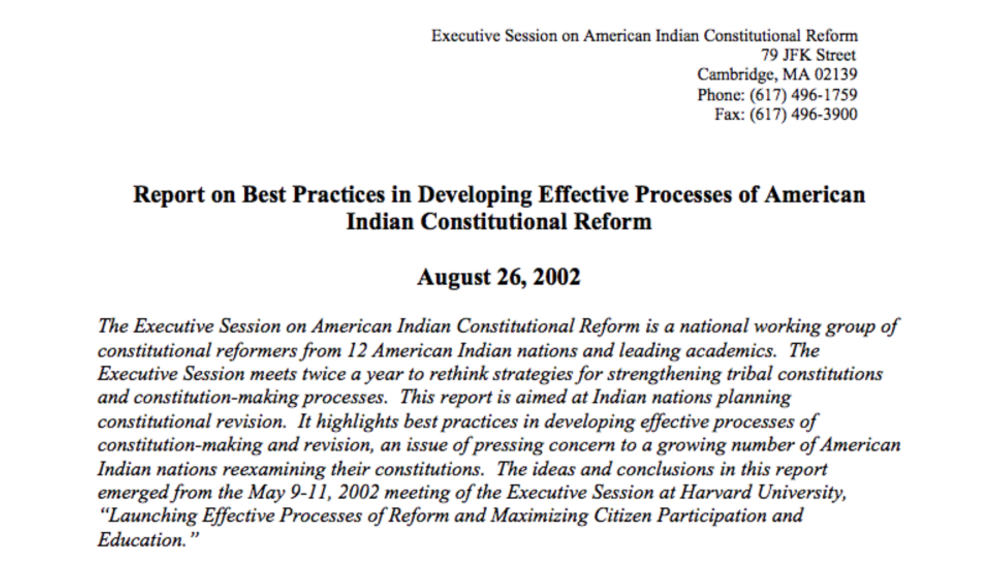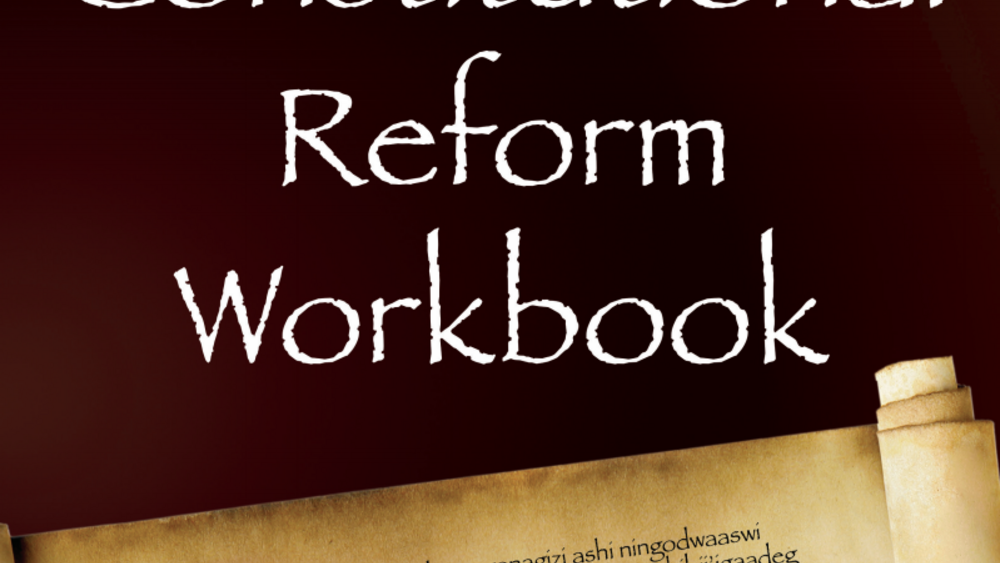Hepsi Barnett, Frank Ettawageshik, Greg Gilham and Donald "Del" Laverdure offer their perspectives on the opportunity that constitutional reform presents Native nations with respect to reintegrating their distinct cultures and identities into their governance systems.
Additional Information
Barnett, Hepsi. "The Osage Government Reform Initiative." Honoring Nations symposium. Harvard Project on American Indian Economic Development, John F. Kennedy School of Government, Harvard University. Cambridge, Massachusetts. September 17, 2009. Presentation.
Ettawageshik, Frank. "Constitutional Reform: A Wrap-Up Discussion (Q&A)." Tribal Constitutions seminar. Native Nations Institute for Leadership, Management, and Policy, University of Arizona. Tucson, Arizona. May 2, 2012. Presentation.
Gilham, Greg. Native Nations Institute for Leadership, Management, and Policy, University of Arizona. Tucson, Arizona. March 25, 2010. Interview.
Laverdure, Donald "Del". Native Nations Institute for Leadership, Management, and Policy, University of Arizona. Tucson, Arizona. August 12, 2010. Interview.
Transcript
Frank Ettawageshik:
It’s not only a good idea, but it’s essential that we tie what we do in our reforms of our governments, that we tie that to our traditions, and in some cases it’s tied to a thriving tradition. In some cases, we have traditions that are evolving or traditions that are being resurrected or strengthened again. But we have to keep that as the foremost reason behind us, because it really is what our identity is, it’s where we come from, it’s who we are, and that is essential to our inherent sovereignty.
Greg Gilham:
They want to, they want to add in a cultural aspect into a new constitution. That gives them some legitimacy as a nation by defining who they are. In our previous constitutions, you don’t have that. You don’t have a definition defining who you are. So, is that adding culture into your [constitution]? You bet it is. Anytime you can put together a preamble within a new constitution defining who you are -- whether you do it in your own language, written out -- that’s really important. That’s important to the Indian nations, and certainly important to ours. That’s what we want to do, is build ourselves into a nation of people, that we can certainly look and be proud of the fact that we don’t need the State of Montana or the federal government telling us who we are. Let’s define ourselves and let them know who we are. And I think that plays a key role.
Donald Del Laverdure:
I think the fact that the new constitution expressly cites our treaties of Fort Laramie -- which is really the foundation of the Crow’s relationship to the federal government and then everything else flows from that -- we have an 1851, 1868 cite and do recognize that there is federal law which is debatable on whether it should’ve been in the constitution or not. But nevertheless saying that we’re Apsáalooke people, have our name set and listed in Crow, and that we list all the districts according to how we understand them. For example, Lodge Grass is in Crow [Crow language], which is the word for ‘Valley of the Chiefs.’ Many chiefs were there historically. And having those types of things in there is important to our identity, our culture, and the future aspirations of where we want to be as governing not only Crows, but anyone within the territory and boundaries of the Crow Nation.
Frank Ettawageshik:
In this document however, there’s a very important thing that we kept. And our culture, our heritage, and the spirit of our ancestors, is central to this document. And I felt the best way I could do that is to read just a little bit of the preamble:
IN THE WAYS OF OUR ANCESTORS, to perpetuate our way of life for future generations, we the Little Traverse Bay Bands of Odawa Indians, called in our own language the WAGANAKISING ODAWAK, a sovereign, self-governing people who follow the Anishinaabe Traditions, Heritage, and Cultural Values, set forth within this Constitution the foundation of our governance. This Constitution is solemnly pledged to respect the individuality of all our members and their spiritual beliefs and practices, while recognizing the importance of preserving a strong, unified Tribal identity in accordance with our Anishinaabe Heritage. We will work together in a constructive, cooperative spirit to preserve and protect our lands, resources and Treaty Rights, and the right to an education and a decent standard of living for all our people. In keeping faith with our Ancestors, we shall preserve our Heritage while adapting to the present world around us.
Hepsi Barnett:
In closing, what I’ll do is I’ll read to you the preamble that was developed for Osage Nation Constitution, because I think it really sums up the principles and values that became the bedrock of that reform effort:
We the Wah-zha-zhe, known as the Osage People, having formed as Clans in the far distant past, have been a People and as a People have walked this earth and enjoyed the blessings of Wah-kon-tah for more centuries than we truly know.
Having resolved to live in harmony, we now come together so that we may once more unite as a Nation and as a People, calling upon the fundamental values that we hold sacred: Justice, Fairness, Compassion, Respect for and Protection of Child, Elder, All Fellow Beings, and Self.
Paying homage to generations of Osage leaders of the past and present, we give thanks for their wisdom and courage. Acknowledging our ancient tribal order as the foundation of our present government, first reformed in the 1881 Constitution of the Osage Nation, we continue our legacy by again reorganizing our government.
This Constitution, created by Osage People, hereby grants to every Osage citizen a vote that is equal to all others and forms a government that is accountable to the citizens of the Osage Nation.
We, the Osage People, based on centuries of being a People, now strengthen our government in order to preserve and perpetuate a full and abundant Osage way of life that benefits all Osages, living and as yet unborn. Thank you.


